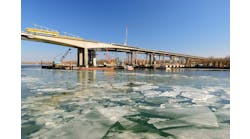By Tom Everett, Contributing Author
The Federal Highway Administration (FHWA) updated its National Bridge Inspection Standards (NBIS) last May. These standards ensure all highway bridges on public roads, as well as federally and tribally owned bridges, receive periodic inspections to maintain their safety for the traveling public.
The 2022 update addressed several requirements established by Congress in the Moving Ahead for Progress in the 21st Century Act (MAP-21). These requirements include updates to the methodology, training, and qualifications for inspection personnel, and a more risk-based approach to bridge inspection intervals.
MAP-21 establishes a national registry of certified bridge inspectors and requires element-level inspection data for bridges on the National Highway System (NHS) to be collected and inventoried. It also ensures uniformity with the National Tunnel Inspection Standards enacted in 2015.
While all these updated requirements are important to preserving the safety of public highway bridges, there are five areas worth highlighting.
Risk-Based Inspection Intervals
Historically, most highway bridges have been inspected on 24-month intervals. The updated regulations now define two risk-based methods for setting appropriate inspection intervals considering specific factors.
The first method offers a simplified assessment approach, while the second offers a more rigorous methodology to determine inspection intervals.
Specific criteria have been established to allow for extended routine inspection intervals up to 48 months, and 72 months for underwater inspections.
The requirements enable the establishment of more rigorous, risk-based intervals. This considers certain factors associated with bridges for routine, underwater and nonredundant steel tension member (formerly known as fracture critical member) inspections that would allow some inspection intervals to be up to 72 months.
The methods for establishing risk-based intervals are based on research summarized in “The National Cooperative Highway Research Program Report 782: Proposed Guideline for Reliability
Based Bridge Inspection Practices,” and the FHWA's current practice for establishing 48-month inspection intervals.
The new options for implementing this approach are rigorous for good reason. The public needs to have confidence that bridge owners are using the best available information to decide how often bridges need to be inspected. The approaches outlined in the regulations balance the importance of safety with the most efficient use of limited resources.
It remains to be seen as to how many bridge owners will take advantage of the more rigorous assessment process, but as inspections become more costly to conduct and the bridge inventory – along with competition for available resources – increases, it is comforting to know that the regulations now provide inspection interval setting flexibilities backed through research and development.
Timeliness
The updated regulations clarify required timeframes for various activities associated with bridge inspections. Whereas the prior regulation required initial inspections of newly constructed or replaced bridges within 90 days for state-owned bridges and 180 days for all others, the updated regulations now require initial inspections for each new, replaced, rehabilitated, and temporary bridge within three months of the bridge opening to traffic.
Similarly, the first underwater inspection for each bridge with portions underwater that have been rehabilitated is required within 12 months of the bridge opening to traffic, and the first Nonredundant Steel Tension Member (NSTM) inspections are required no later than 12 months of the bridge opening to traffic.
The regulations establish new requirements associated with assessing a bridge’s load rating and the proper posting of limitations or restrictions of loads. Each bridge is now to be rated for its safe load carrying capacity within 30 days of the initial inspection or when a change is identified that warrants a fresh look at the load rating.
Another 30 days is allowed for proper posting once a load rating determines that it is needed.
The revisions also provide some leniency for inventory data timeliness. The 2004 regulations required inventory and appraisal data to be inputted within 90 days of the inspection date.
Now, the new regulations require data changes to be updated within three months after the month the inspection was completed. This change allows inspectors to better manage their field time, get an early monthly start to field work and utilize the entirety of the month to ensure quality inspections without the burden of the 90-day clock counting down on the initial inspections.
New Data Items
The incorporation by reference of the March 2022 Specifications for the National Bridge Inventory (SNBI) is one of the most significant updates in the regulations. These new data specifications replace a guidance document that has been in place since December 1995.
Besides switching from metric to U.S. customary units of measure, the SNBI establishes 54 new items and discontinues 20 items from the 1995 guidance. The initial inspection defines 113 of the total items, while 37 items are to be identified for each inspection.
The new and expanded item codes (e.g., span material and type) have significantly increased the amount of data to be recorded. Other new information to be collected includes the bridge and transition railing crash test-level and general condition rating, along with separate scour vulnerability and scour condition rating.
The new SNBI defines data items and specifications that provide an improved ability to assess and monitor bridge safety. When implemented, the SNBI should result in improved bridge data quality, better information for managing bridge assets and more informed reporting to stakeholders, including Congress and the public.
In recognition of the magnitude of this change and the time required to make the necessary revisions to data collection systems and processes, the 1995 guidance document will not sunset until the end of 2025.
Many of the new SNBI items are currently being evaluated at the state level through their respective NBI procedures and element processes. This federal change creates consistency and alignment across the country.
It also reduces variability and the inspector learning curve when crossing state lines. Creating a database of nationally qualified bridge inspectors with an aligned approach to data collection creates a larger pool of resources for departments of transportation to tap into.
Critical Finding Tracking and Resolution
The updated regulations strengthen the process for identifying and reporting critical findings by establishing a consistent national definition and by elevating the reporting of all critical findings to the FHWA.
Although there is now a national definition, bridge owners are encouraged to develop more stringent criteria that align with the issues they experience in their bridge inventory.
The new requirement establishes a 24-hour initial notification period and monthly reporting of critical findings to FHWA until each finding is resolved. The new provisions in the regulation are intended to raise the level of awareness and accountability for identifying and resolving bridge safety concerns.
Enhanced Qualifications
Comprehensive and periodic refresher training for bridge inspectors has been an important part of the NBIS regulations for years. The recent update to the regulations takes training to new levels.
The regulations now include a requirement for mandatory refresher training for bridge inspection program managers. New requirements for team leaders on non-redundant steel tension member inspections include specialized training on NSTM inspections. Underwater bridge inspection divers are also now required to complete specialized training on underwater bridge inspection.
Also new to the regulations: A requirement for state transportation departments, federal agencies, and tribal governments to define their own personnel qualifications for those involved in damage, special and service inspection types. Lastly, the regulations add valuable descriptions of the content for the various types of required training including comprehensive, refresher, underwater and NSTM inspection.
The enhanced refresher training requirements will result in consistency among team leaders and provide opportunities for trainers to highlight challenges specifically geared toward bridge inspection. Additional training on construction and maintenance of bridges is certainly still valuable and adds depth to our inspectors’ knowledge of bridge construction and maintenance.
The U.S. has a longstanding successful national bridge inspection program. The heart of the program is the NBIS regulations. The update to these regulations will further strengthen the program, keeping highway bridges in our country safe for many years to come. R&B
Thomas D. Everett, P.E., is a vice president with RS&H, and he is the former executive director of the Federal Highway Administration (FHWA). He can be reached at [email protected].



